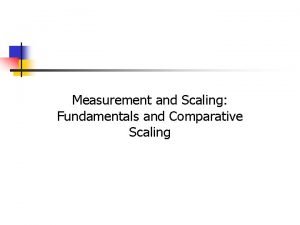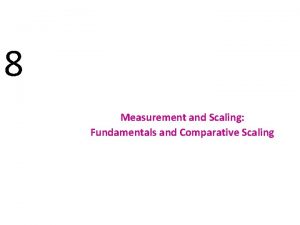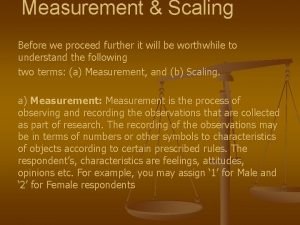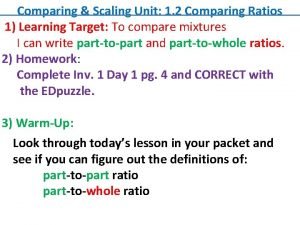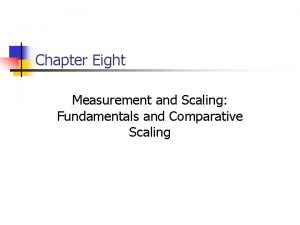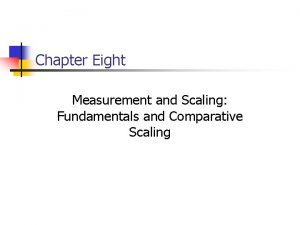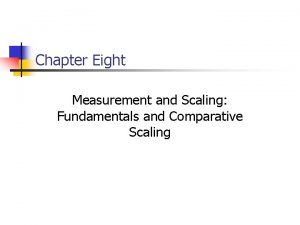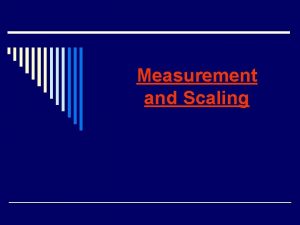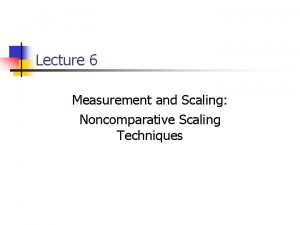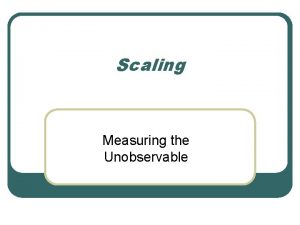Lecture 5 Measurement and Scaling Fundamentals and Comparative

















- Slides: 17

Lecture 5 Measurement and Scaling: Fundamentals and Comparative Scaling

8 -2 Primary Scales of Measurement Scale Nominal Ordinal Symbols Assigned to Runners Finish B o b Ratio G e n e Rank Order of Winners 3 rd place Interval S a m Performance Rating on a 0 to 10 Scale Time to Finish, in Seconds 3 15. 2 2 nd place 1 st place 7 14. 1 9 13. 4 Finish

Primary Scales of Measurement 8 -3 Nominal Scale n n n The numbers serve only as labels or tags for identifying and classifying objects. When used for identification, there is a strict one-toone correspondence between the numbers and the objects. The numbers do not reflect the amount of the characteristic possessed by the objects. The only permissible operation on the numbers in a nominal scale is counting. Only a limited number of statistics, all of which are based on frequency counts, are permissible, e. g. , percentages, and mode.

Primary Scales of Measurement 8 -4 Ordinal Scale n n A ranking scale in which numbers are assigned to objects to indicate the relative extent to which the objects possess some characteristic. Can determine whether an object has more or less of a characteristic than some other object, but not how much more or less. Any series of numbers can be assigned that preserves the ordered relationships between the objects. In addition to the counting operation allowable for nominal scale data, ordinal scales permit the use of statistics based on centiles, e. g. , percentile, quartile, median.

Primary Scales of Measurement 8 -5 Interval Scale n n n Numerically equal distances on the scale represent equal values in the characteristic being measured. It permits comparison of the differences between objects. For example, the difference between 1 and 2 is the same as between 3 and 4. The difference between 1 and 9 (i. e. , 8) is twice as large as the difference between 2 and 4 (i. e. , 2) or 6 and 8 (2). The location of the zero point is not fixed. Both the zero point and the units of measurem. are arbitrary. It is NOT meaningful to take ratios of scale values It IS meaningful to take ratios of their differences. Statistical techniques that may be used include all of those that can be applied to nominal and ordinal data, and in addition the arithmetic mean, standard deviation, correlation, and other common statistics.

Primary Scales of Measurement 8 -6 Ratio Scale n n n Possesses all the properties of the nominal, ordinal, and interval scales. It has an absolute zero point. Examples: height, weight, age, money, sales, costs, market share, number of customers, the rate of return. It is meaningful to compute ratios of scale values. For example, not only is the difference between 2 and 5 the same as the difference between 14 and 17, but also 14 is seven times as large as 2 in an absolute sense. All statistical techniques can be applied to ratio data.

8 -7 Illustration of Primary Scales of Measurement Nominal Scale Ordinal Scale Interval Scale Ratio Scale No. Store Preference Rankings Preference Ratings 1 -7 11 -17 $ spent last 3 months 1. Lord & Taylor 2. Macy’s 3. Kmart 4. Rich’s 5. J. C. Penney 6. Neiman Marcus 7. Target 8. Saks Fifth Avenue 9. Sears 10. Wal-Mart

8 -8 Primary Scales of Measurement

8 -9 A Classification of Scaling Techniques Noncomparative Scales Comparative Scales Paired Comparison Rank Order Constant Sum Q-Sort and Other Procedures Likert Continuous Itemized Rating Scales Semantic Differential Stapel

Comparative Scaling Techniques 8 -10 Paired Comparison Scaling n n n A respondent is presented with two objects and asked to select one according to some criterion. The data obtained are ordinal in nature. Paired comparison scaling is the most widely used comparative scaling technique. With n brands, [n(n - 1) /2] paired comparisons are required (no good when n is large) Under the assumption of transitivity (if A is better than B, and B is better than C, then A is better than C), it is possible to convert paired comparison data to a rank order. Does not match real life well: consumers face multiple choices rather than two at a time.

Obtaining Shampoo Preferences Using Paired Comparisons 8 -11 Instructions: We are going to present you with ten pairs of shampoo brands. For each pair, please indicate which one of the two brands of shampoo you would prefer for personal use. Recording Form: a. A 1 in a particular box means that the brand in that column was preferred over the brand in the corresponding row. A 0 means that the row brand was preferred over the column brand. b. The number of times a brand was preferred is obtained by summing the 1 s in each column.

Comparative Scaling Techniques 8 -12 Rank Order Scaling n n n Respondents are presented with several objects simultaneously and asked to order or rank them according to some criterion. It is possible that the respondent may dislike the brand ranked 1 in an absolute sense. Furthermore, rank order scaling also results in ordinal data. Only (n - 1) scaling decisions need be made in rank order scaling. Better resembles real life shopping (multiple choices)

Preference for Toothpaste Brands Using Rank Order Scaling Instructions: Rank the various brands of toothpaste in order of preference. Begin by picking out the one brand that you like most and assign it a number 1. Then find the second most preferred brand assign it a number 2. Continue this procedure until you have ranked all the brands of toothpaste in order of preference. The least preferred brand should be assigned a rank of 10. No two brands should receive the same rank number. The criterion of preference is entirely up to you. There is no right or wrong answer. Just try to be consistent. 8 -13

Preference for Toothpaste Brands Using Rank Order Scaling Form Brand Rank Order 1. Crest _____ 2. Colgate _____ 3. Aim _____ 4. Gleem _____ 5. Macleans _____ 6. Ultra Brite _____ 7. Close Up _____ 8. Pepsodent _____ 9. Plus White _____ 10. Stripe _____ 8 -14

Comparative Scaling Techniques 8 -15 Constant Sum Scaling n n Respondents allocate a constant sum of units, such as 100 points to attributes of a product to reflect their importance. If an attribute is unimportant, the respondent assigns it zero points. If an attribute is twice as important as some other attribute, it receives twice as many points. The sum of all the points is 100. Hence, the name of the scale.

Importance of Bathing Soap Attributes Using a Constant Sum Scale Instructions On the next slide, there are eight attributes of bathing soaps. Please allocate 100 points among the attributes so that your allocation reflects the relative importance you attach to each attribute. The more points an attribute receives, the more important the attribute is. If an attribute is not at all important, assign it zero points. If an attribute is twice as important as some other attribute, it should receive twice as many points. 8 -16

Importance of Bathing Soap Attributes Using a Constant Sum Scale Form Average Responses of Three Segments Attribute 1. Mildness 2. Bubbles 3. Shrinkage 4. Price 5. Fragrance 6. Packaging 7. Moisturizing 8. Cleaning Power Sum Segment II 8 -17 Segment III
 What is comparative scale
What is comparative scale Manoj kuamr
Manoj kuamr Scales of measurement
Scales of measurement What is comparative scale
What is comparative scale Interval scale
Interval scale Scaling techniques
Scaling techniques Stapel scale example
Stapel scale example Non comparative scaling
Non comparative scaling Comparative scale examples
Comparative scale examples Before we proceed further
Before we proceed further Methodology in research paper example
Methodology in research paper example Process instrumentation ppt
Process instrumentation ppt 01:640:244 lecture notes - lecture 15: plat, idah, farad
01:640:244 lecture notes - lecture 15: plat, idah, farad Comparative performance measurement system
Comparative performance measurement system Chen
Chen Outsystems ui patterns
Outsystems ui patterns Shifting and scaling graphs
Shifting and scaling graphs Comparing and scaling unit test
Comparing and scaling unit test
